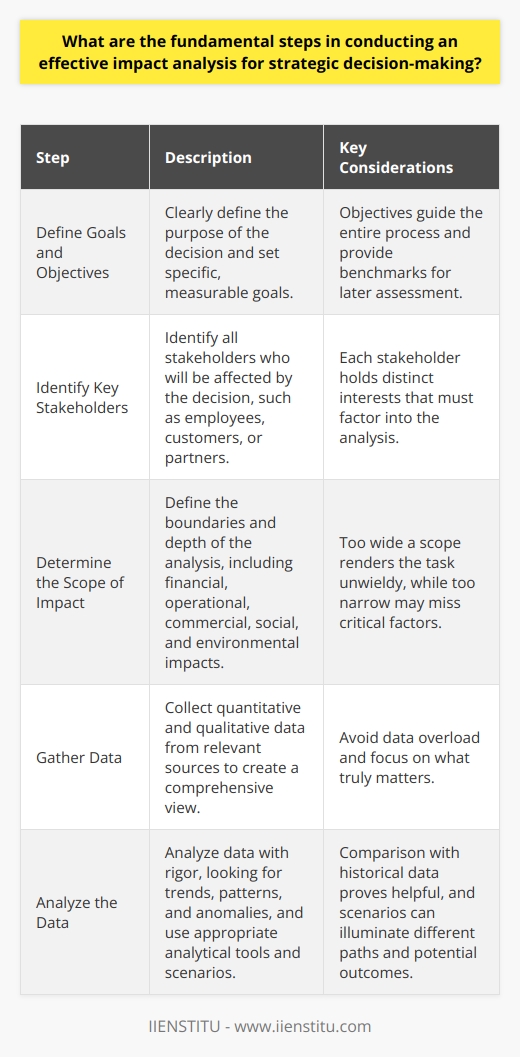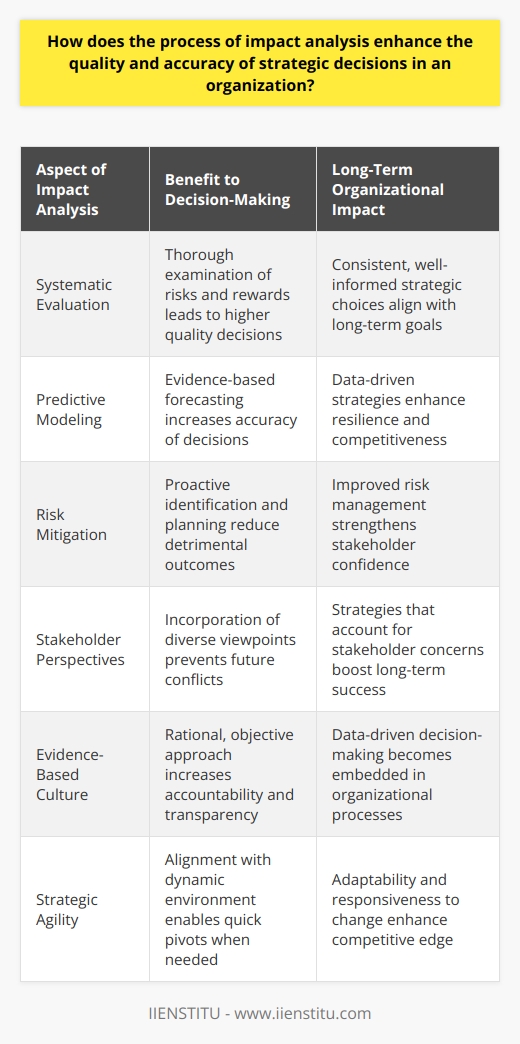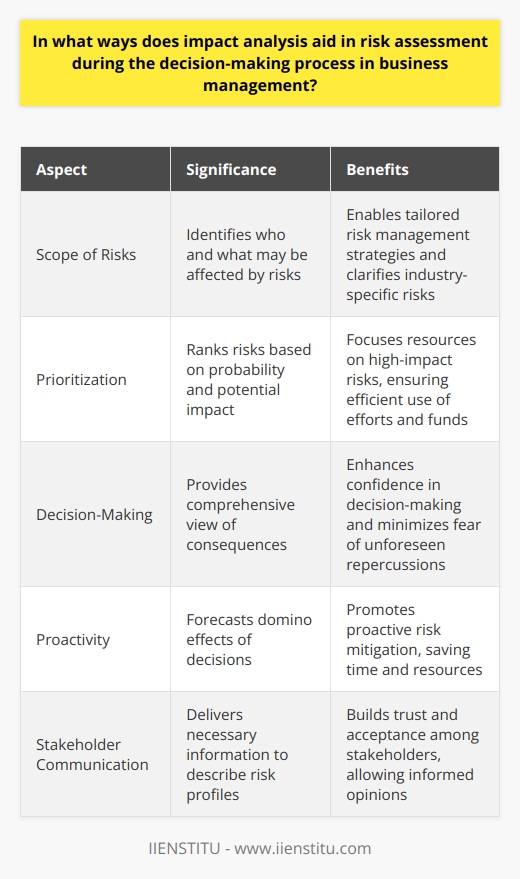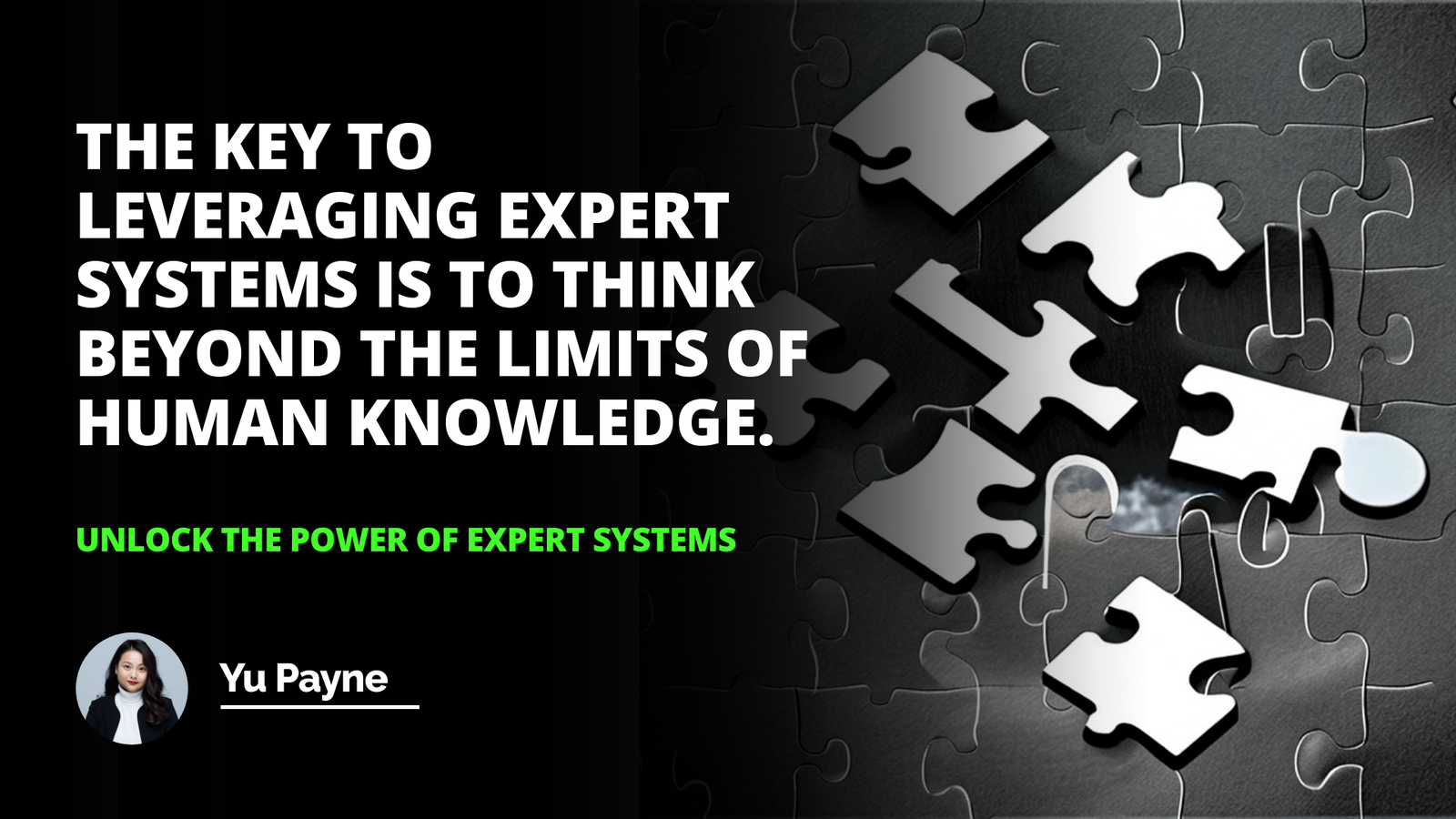
Introduction
In an increasingly complex and interconnected world, strategic decision making has become a challenging endeavor for leaders across all sectors. An essential component of this decision-making process is understanding the far-reaching effects that choices can have, whether within a corporate entity, community, or the environment at large. Impact analysis emerges as an indispensable tool in the realm of informed decision-making, offering a structured approach to predicting and evaluating potential consequences of actions before they are undertaken. Through the integration of a problem solving techniques course or online certificate courses, professionals can enhance their strategic acumen and steer towards more sustainable and beneficial outcomes. This article delves into the various facets of impact analysis, discussing its definitions, types, processes, and real-world applications, in addition to exploring the inherent challenges and strategies to overcome them.
What is Impact Analysis?

Defining Impact Analysis
Impact analysis constitutes a critical methodological approach used by individuals and organizations to forecast the potential outcomes – both positive and negative – that may result from a proposed action or decision. This predictive tool helps stakeholders visualize the ripple effect of their actions across various dimensions and time-frames, thus facilitating more sophisticated planning and risk management. Impact analysis caters to a range of scenarios, from policy implementation and infrastructure projects to corporate expansions and technological upgrades.
Importance of Impact Analysis
The importance of impact analysis lies in its capacity to inform decision-makers about the potential benefits and detriments of their choices, prior to their enactment. It serves as a preventative measure, identifying potential issues and fostering proactive responses, rather than reactive ones. Impact analysis aids in the optimization of resources, the minimization of adverse effects, and the enhancement of positive outcomes, all of which are critical to the robustness and ethical essence of a project or policy.
Types of Impact Analysis

Environmental Impact Analysis
Environmental impact analysis is a systematic process used for assessing the likely environmental consequences of proposed developments or activities. It is a pivotal step in ensuring that the potential ecological disturbances and the broader implications for biodiversity, natural resources, and climate are taken into account during the planning stages of any project. This foresight is instrumental in promoting sustainability and in fulfilling legal and ethical obligations towards environmental stewardship.
Social Impact Analysis
Social impact analysis scrutinizes the effects of initiatives on human communities. It encompasses the assessment of how a project might influence aspects of public life including employment opportunities, social cohesion, community health, and access to services. The insights garnered from such analyses are crucial for building inclusive strategies that serve and respect the interests of all community members, particularly those who could be disproportionately affected.
Economic Impact Analysis
Economic impact analysis evaluates the direct, indirect, and induced monetary effects that a proposed action might have on the economy at local, regional, or national levels. This can include the creation or loss of jobs, the stimulation or disruption of local businesses, and broader fiscal implications. Understanding these economic dynamics ensures that investments bring genuine progress and do not inadvertently cause financial instability or inequity.
Business Impact Analysis
In the corporate arena, business impact analysis is employed to anticipate the consequences of business disruptions and to develop strategies for maintaining operations and minimizing losses. It forms a core component of business continuity planning, ensuring organizational resilience and the safeguarding of critical functions and assets against a myriad of possible disturbances.
Process of Conducting an Impact Analysis

Identification of the change
The initial step in conducting impact analysis is the clear identification and articulation of the proposed change or action. This encompasses a comprehensive understanding of the project's objectives, scope, and the components involved. It is the outlining of the blueprint which will undergo scrutiny in the subsequent stages of analysis.
Determining the impacts
Upon identifying the change, the next phase involves predicting the possible primary, secondary, and even tertiary effects that may cascade from the action. This requires both quantitative and qualitative methodologies, ranging from data modelling and simulations to stakeholder consultations and expert analysis. These projections form the substance of what the impact analysis seeks to explore and assess.
Assessing the changes
After mapping out potential impacts, a rigorous assessment phase begins. Specialists evaluate the magnitude, likelihood, and duration of each impact, taking into account varying scenarios and sensitivities. This phase often integrates interdisciplinary insights to ensure a well-rounded evaluation, drawing upon technical, economic, social, and environmental expertise as relevant.
Formulating mitigation strategies
The culmination of the analysis process is the formulation of mitigation strategies for any identified negative impacts or the enhancement of positive ones. Bespoke plans, which may include preventive measures, compensatory actions, or contingency arrangements, are developed. These strategies aim to balance benefits and costs effectively, ensuring the project is optimally aligned with broader strategic goals and values.
Impact Analysis in Project Management

Role of impact analysis in project management
In the realm of project management, impact analysis serves a central role in steering projects toward successful outcomes. It equips project managers with insights into how changes can affect project scope, timeline, costs, and quality, enabling informed decision-making throughout the project life cycle. By predicting potential roadblocks and opportunities, managers can adapt their strategies dynamically, maintaining project alignment with organizational and stakeholder expectations.
Tools and techniques utilized in impact analysis
For a robust impact analysis, a host of specialized tools and techniques are employed. These include workflow diagrams, change logs, impact matrices, and stakeholder analysis tools. Moreover, software applications that facilitate scenario modelling and probability analysis are increasingly being integrated. These digital solutions enhance the precision and efficiency of impact assessments, propelling project management practices into an era of data-driven decision support.
Real-World Examples of Impact Analysis
Case study 1: Impact analysis in a business scenario: Consolidating the theoretical aspects of impact analysis are real-world applications like the implementation of a new enterprise software system within a corporation. Prior to adoption, a thorough impact analysis can reveal potential disruptions to workflows, necessary employee training programs, and infrastructure upgrades. By anticipating these factors, businesses can preemptively address them, ensuring a smoother transition and better return on investment.
Case study 2: Impact analysis in environmental matters: In the environmental arena, a proposal for a new transportation infrastructure project exemplifies the necessity of comprehensive impact analysis. Before breaking ground, an environmental impact analysis assesses issues such as emission increases, habitat fragmentation, or water resource depletion. A systematic approach leads to adaptive planning, such as the inclusion of green bridges or noise containment measures to mitigate the identified impacts.
Impact Analysis in the Context of Change Management
Depicting the correlation between change management and impact analysis
Change management and impact analysis are intrinsically linked; each informs and enhances the other. Impact analysis provides the data and insights needed to navigate the intricate process of organizational change. It charts the landscape of potential barriers and facilitators, contributing to a change management strategy grounded in evidence and foresight.
Methods for incorporating impact analysis in change management strategies
Inculcating impact analysis within change management involves a series of methodical steps. It starts from the top-tier visioning and cascades down to the tactical engagement of stakeholders. Methods may include conducting workshops to dialogue on identified impacts, developing communication plans tailored to convey the implications of change, and establishing monitoring systems to observe and respond to unfolding impacts throughout the implementation phase.
Challenges in Impact Analysis
Potentially flawed assumptions
One of the critical challenges in impact analysis involves dealing with the assumptions that underpin models and forecasts. Erroneous assumptions can skew results and lead to suboptimal decisions. It is, therefore, pivotal to constantly review and validate the hypotheses that serve as the foundation of the analysis.
Subjectivity in the assessment process
Impact analysis, by its nature, occasionally wades into subjective territory, especially when dealing with qualitative impacts. The challenge lies in striking a balance between subjective judgments and objective evidence. Analysts must navigate this delicate balance to ensure that the analyses remain scientifically robust and transparent.
Resource-intensive and timely processes
The comprehensive nature of impact analysis can often demand significant resources and time, which can be challenging for organizations facing constraints. This intricacy can act as a deterrent to its adoption, despite the long-term benefits it affords.
How to Overcome the Challenges in Impact Analysis
Investing in thorough data collection
To surmount the challenges posed by uncertain data, investing in meticulous and multifaceted data collection efforts is paramount. Maintaining up-to-date repositories of information and contextual insights fortifies the analysis against inaccuracies and enhances the legitimacy of its findings.
Encouraging transparency and objectivity
Combatting the subjectivity challenge requires a commitment to transparency and the active pursuit of objectivity. This might involve stakeholder engagement to validate perceived impacts or the employment of external audits to evaluate the analysis's integrity.
Using consistent methodologies that allow room for adjustments
Adopting standardized methodologies while remaining open to calibration ensures that the process is capable of adapting to new insights and correcting course as required. Consistency applies a replicable framework that can be enhanced iteratively over time, nurturing a culture of continuous learning and improvement.
Conclusion
Summarising the importance and applications of impact analysis
Impact analysis stands as a key tool for strategic decision-making, with the power to guide projects and policies through the complex terrain of contemporary challenges. By anticipating and evaluating the ramifications of potential actions, it aids in the orchestration of initiatives that are not only successful but also responsible. The incorporation of this analytical technique across various types of analysis reveals its versatility and vital role in underpinning sound judgment and foresight.
Restating the significance of proper execution for accurate results and strategic planning
The cogency of impact analysis is inherently linked to its meticulous execution. Proper conduct of impact analysis warrants accurate results, enabling strategic planning that is both informed and reliable. As organizations look to remain resilient and thrive in an ever-evolving landscape, mastering impact analysis thus becomes not merely advantageous but essential. While challenges are inherent in the process, the strategies to overcome them reaffirm the principle that foresight, coupled with rigor, cultivates decisions that can withstand the test of time and change.
Frequently Asked Questions
What are the fundamental steps in conducting an effective impact analysis for strategic decision-making?
Understanding Impact Analysis
Impact analysis forms a critical part in strategic decision-making. It requires methodical evaluation. Decision-makers need to comprehend potential changes. These changes may arise from strategic actions. The focus rests on cause and effect. Sound analysis can predict possible outcomes effectively.
Step 1: Define Goals and Objectives
Clarity reigns supreme. Clearly define the decision's purpose. Set specific, measurable goals. Without clear objectives, meaningful analysis proves elusive. Objectives guide the entire process. They also provide benchmarks for later assessment.
Step 2: Identify Key Stakeholders
Know who will be affected. Identify all stakeholders early. They could be employees, customers, or partners. Each holds distinct interests. These interests must factor into the analysis.
Step 3: Determine the Scope of Impact
Scope delineates boundaries. It defines the depth of analysis. Decide what areas to assess. Include financial, operational, and commercial impacts. Also, consider social and environmental effects. Too wide a scope renders the task unwieldy. Too narrow, and critical factors may be missed.
Step 4: Gather Data
Data underpins the entire process. Collect from relevant sources. Quantitative data allows for numerical assessment. Qualitative insights help understand sentiments. Both forms create a comprehensive view. Avoid data overload. Focus on what truly matters.
Step 5: Analyze the Data
Analyze with rigor. Look for trends, patterns, and anomalies. Use appropriate analytical tools. Comparison with historical data proves helpful. Scenarios can illuminate different paths. They show potential outcomes of decisions.
Step 6: Evaluate Risks and Opportunities
Weigh the risks. Count potential benefits. Risks might be financial, operational, or reputational. Opportunities could open new markets. They may streamline operations. Understanding both helps in crafting a resilient strategy.
Step 7: Develop Impact Statements
Create succinct impact statements. They summarize potential effects. Use them to communicate findings. Statements should be evidence-based. They guide stakeholders through the analysis. Decision-makers use them to contemplate next steps.
Step 8: Recommend Actions
Offer clear recommendations. They emerge from thorough analysis. Recommendations should align with goals. They should also account for stakeholder interests. Prioritize actions based on impact magnitude and likelihood.
Step 9: Create Monitoring and Evaluation Plans
Tracking progress is essential. Develop monitoring mechanisms. Establish evaluation criteria. They measure the decision's effectiveness over time. Ongoing evaluation enables course corrections. It ensures alignment with original objectives.
Conclusion
Every strategic decision carries weight. Effective impact analysis can light the way. It brings discipline to decision-making. It equips leaders with foresight. Above all, it helps build strategic actions that stand the test of time.
By adhering to these steps, an organization enhances its ability to forge a robust, forward-thinking strategy.

How does the process of impact analysis enhance the quality and accuracy of strategic decisions in an organization?
Impact Analysis Fundamentals
Organizations face decisions that can alter their trajectory significantly. Impact analysis serves as a critical tool in shaping these strategic choices. At its core, impact analysis examines the probable outcomes of a decision. It seeks to forecast the consequences that would follow various strategic paths.
Importance of Systematic Evaluation
Impact analysis offers a systematic approach to decision-making. Decision-makers do not act on impulse. They rely on a detailed examination of potential risks and rewards. This involves considering every aspect of a decision. That includes the direct and indirect effects it might have. Such thoroughness undoubtedly leads to higher quality decisions.
Enhancing Decision Quality
First, impact analysis prompts a broader view of potential outcomes. It forces leaders to look beyond the immediate effects. They must consider the long-term implications of their decisions. This helps to avoid myopic thinking. It ensures that strategies align with long-term goals.
Increasing Accuracy with Predictive Insights
Second, impact analysis involves predictive modeling. This employs data to forecast likely scenarios. Leaders can thus make decisions backed by evidence, not guesswork. Analysis tools and techniques vary in complexity. Yet, they share the common goal of providing a realistic preview of the future. This boosts the accuracy of strategic choices.
Mitigating Risks Through Prior Assessment
Third, the process identifies potential risks beforehand. Firms can then devise mitigating strategies proactively. It is crucial to tackle risks before they balloon into crises. This anticipatory action reduces the possibility of detrimental outcomes. It also shows stakeholders the firm's proactive stance on risk management.
Incorporation of Stakeholder Perspectives
Fourth, impact analysis typically includes stakeholder perspectives. These perspectives provide insight into how decisions affect various groups. Early identification of stakeholder concerns can prevent future conflicts. It also ensures that strategies account for and are sensitive to these concerns.
Promoting a Culture of Evidence-Based Decision Making
Fifth, conducting impact analysis fosters a culture of evidence-based decision making. This culture values data over intuition. It encourages a rational, objective approach in strategic planning. As such, organizations embed a higher standard of accountability and transparency in their processes. This cultural shift propels organizations towards more intentional and informed decision-making.
Strengthening Strategic Agility
Lastly, impact analysis can improve an organization’s strategic agility. It does this by ensuring decisions align with dynamic environment factors. Firms that frequently engage in impact analysis become adept at predicting and responding to changes. They are better equipped to pivot quickly when necessary.
Conclusion
In essence, impact analysis significantly improves the quality and accuracy of strategic decisions. Businesses that embed this process into their decision-making fabric are more robust. They not only navigate uncertainties better but also capitalize on opportunities more effectively. With its predictive nature and evidence-based orientation, impact analysis is an indispensable component of strategic planning. Adopting such analytical rigour affords organizations a decisive edge in the competitive business landscape.

In what ways does impact analysis aid in risk assessment during the decision-making process in business management?
Understanding Impact Analysis in Risk Assessment
Impact analysis stands as a critical tool. It identifies potential consequences of decisions. Businesses use this for informed risk assessment. Managers ascertain the severity and reach of risks.
Clarifying the Scope of Risks
Impact analysis breaks down the elements of risk. It determines who and what may suffer. This makes the scope of risk clear. It aids in tailoring risk management strategies. Industry-specific risks gain clarity. Leaders understand the breadth of possible outcomes.
Prioritizing Risks Effectively
Some risks matter more than others. Impact analysis helps in ranking them. It considers both probability and potential impact. High-impact risks gain immediate attention. Resources concentrate on these top risks. This ensures efficient use of efforts and funds.
Enhancing Decision-Making Confidence
Knowledge dispels uncertainty. Impact analysis provides this knowledge. Decision-makers can act with more confidence. They understand the implications of their choices. A comprehensive view of consequences guides this process. It minimizes the fear of unforeseen repercussions.
Supporting Proactive Risk Management
Proactivity defines successful businesses. Impact analysis promotes a proactive stance. It forecasts the domino effects of decisions. Managers can take steps to mitigate risks early. This proactive approach saves time and resources. It reduces the need for reactive measures.
Informing Stakeholders
Communication with stakeholders is critical. Impact analysis delivers the necessary information. It effectively describes risk profiles. Potential impacts on stakeholders become clear. This transparency builds trust and acceptance. Stakeholders can weigh in with informed opinions.
Reducing Long-Term Vulnerabilities
Every decision shapes a company's future. Impact analysis explores long-term effects. It helps in avoiding decisions that may cause long-term harm. Businesses position themselves better against future uncertainties. They create robust strategies for sustainability and growth.
Facilitating Compliance and Ethical Responsibility
Regulatory compliance is non-negotiable. Impact analysis assists in aligning decisions with regulations. It also encourages ethical decision-making. Companies can anticipate legal or ethical implications. This maintains a company's integrity and public image.
Streamlining Project Management
Projects come with inherent risks. Impact analysis is useful in project management. It anticipates project-specific risks. Teams prepare for potential roadblocks. Projects meet their objectives with fewer interruptions. Delays and cost overruns decrease.
Enhancing Crisis Preparedness
Crises often come unannounced. Impact analysis fosters crisis readiness. Organizations foresee potential crisis scenarios. They develop in-depth contingency plans. This preparedness minimizes the impact of actual crises. Companies recover more swiftly. They safeguard their assets and reputation.
Guiding Resource Allocation
Resources are always finite. Impact analysis drives strategic allocation. It pinpoints areas that require more attention. Funds, personnel, and time distribute more intelligently. This ensures a more resilient business structure.
To conclude, impact analysis significantly enriches risk assessment. It grants clarity, confidence, and strategic advantage in decision-making. It upholds a business's capacity to thrive amid uncertainties. This analytical tool is indispensable for proactive and insightful management.



